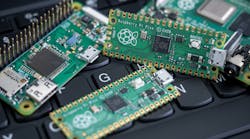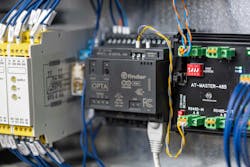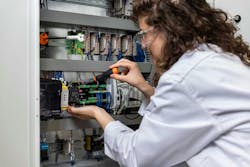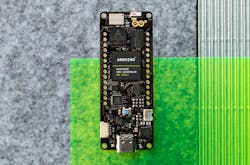Arduino’s CEO on the Commercial Future of Open-Source Hardware
Arduino has become one of the key building blocks of the open hardware movement. Arduino, the platform, is designed to be modular, affordable, and easy for virtually anyone to use. The company behind it has rolled out development boards in droves over the last decade and a half and the software to program them all.
Besides students, tinkerers, and other makers, it’s also widely used by engineers for rapid prototyping of IoT and other electronic projects, with the goal of turning them into commercial products down the line.
“Today’s new generation of engineers grew up building with Arduino,” said Massimo Banzi, Arduino’s co-founder and chairman, when the company announced plans to expand its U.S. operations around a year ago.
But with many of these engineers now moving into high-level engineering and product development roles, CEO Fabio Violante wants to make it as easy as possible for them to take Arduino’s hardware along for the ride.
Arduino is going all-out to give them high-performance hardware with ruggedness and reliability for use in industrial control, robotics, and other systems. The company introduced Arduino Pro help remove some of the obstacles that had made it difficult to move Arduino-based prototypes to mass production with the same hardware. The company has claimed more than 1,000 customers are already on board with its Pro hardware, which, importantly, is compatible with the vast resources of Arduino’s open-source community, said Violante.
>>Check out this TechXchange for similar articles and videos
The Arduino Pro line spans everything from industrial-grade computer modules—highlighted by the Portenta line of system-on-modules (SOMs) that can run everything from a real-time operating systems (RTOS) to Linux—and intelligent sensors—including its Nicla family of voice, vision, and sensor processor boards—to the Arduino Pro IDE and other software development tools with more of the features that the “pros” are accustomed to.
The latest member of the Pro family is the Arduino Opta, its secure, modular programmable logic controller (PLC) targeting the industrial IoT. PLCs are widely used in the world of industrial automation, and they can be programmed to control the movement of robots and other machinery on factory floors. While compact and relatively limited in terms of its I/O, Arduino said the Opta’s combination of computing power, flexible programming, modular design, and affordable price will help make industrial control more accessible.
The Opta is based on Arduino’s Portenta H7 module, giving it the ability to tolerate harsh temperatures and other tough industrial conditions. The cube-shaped device also enables expansion modules to add different functions.
As opposed to the proprietary connectors used on factory floors, Opta leverages Wi-Fi, Bluetooth, Ethernet, and other connectivity standards. Arduino worked with Blues Wireless to roll out wireless modules that can bring cellular or LoRa connectivity to any Opta and then connect it to a cloud, including Arduino’s cloud.
Opta is also embedded in Arduino’s ecosystem, offering access to thousands of code libraries, tutorials, and other resources that customers can use to rapidly prototype, troubleshoot, and even collaborate on projects.
We reached out to Violante to discuss where Opta fits into Arduino’s future and hear the CEO’s thoughts on the future of open-source hardware in the commercial space. This discussion has been edited for clarity.
How has Arduino’s user base evolved since it announced Arduino Pro?
Since announcing the Arduino Pro range, our user base has significantly diversified and expanded. Arduino was already a popular platform in the professional market as a rapid prototyping tool. However, with the introduction of Arduino Pro, we have seen a substantial increase in professional engineers, developers, and industrial stakeholders who now use our platforms for full-scale, end-product development. This evolution reflects a growing recognition of the ease of use, reliability, scalability, and versatility of Arduino solutions for professional and industrial applications.
How is that evolution shaping the design of Arduino’s hardware platforms?
The evolution of our user base toward more professional and industrial applications has directly influenced the design of our hardware platforms. We now prioritize features such as enhanced performance, connectivity, and integration capabilities.
For example, our Pro line, including products like the Portenta and Opta, incorporates robust processing power, advanced security features, extended temperature range, and form factors more suitable for professional applications. These enhancements are designed to meet the specific needs of professional developers and industrial environments, ensuring our products are not only innovative, but also reliable and scalable.
This evolution is also benefiting our other target segments, from hobbyists to artists to educators. The Arduino GIGA R1 board, for example, shares the same powerful STM32H747 microcontroller of the Portenta H7, with a prototyping-friendly form factor and an affordable price point for the general public.
Opta was the company’s first offering for programmable logic controllers. Why does the company call it a “micro-PLC”? Is it related to the expansion modules that can be plugged into it?
We refer to Opta as a “micro-PLC” because it combines the core functionalities of traditional PLCs with the compact form factor and flexibility of Arduino’s ecosystem. The term “micro” signifies its smaller size and the modular nature that allows for expansion through various plug-in extension modules. This design enables users to customize and scale their automation solutions without the constraints typically associated with larger, more rigid PLC systems.
You have previously said of the Opta, “We lower barriers to industrial automation, enabling a broad range of projects that were unthinkable or unapproachable not long ago.” Can you elaborate on that? What can developers do with the Opta and other open-source hardware that they couldn’t—or typically wouldn’t—do with proprietary hardware?
Opta and other open-source hardware lower the barriers by offering affordability, flexibility, and ease of use to anyone. Opta can be programmed with both the Arduino language and traditional IEC PLC languages. For example, users can write functions and blocks in Arduino code that can then be called from Ladder Logic. This breaks the barriers of predefined functions provided out of the box in the traditional world. Additionally, having a vast ecosystem of libraries available for Arduino, users can easily solve complex integration problems.
This approach helps companies cope with the skill shortage affecting the automation engineering world, by tapping into a broader population of young talents familiar with Arduino because they learned it in schools and universities.
Finally, with Opta, developers can create sophisticated automation solutions without the steep costs or proprietary restrictions of traditional hardware.
Open-source platforms foster innovation by allowing users to modify, enhance, and share their projects. This collaborative environment encourages experimentation and customization, enabling projects that may have been financially or technically unfeasible with proprietary systems. Developers can now rapidly prototype, iterate, and deploy automation solutions tailored to their specific needs, accelerating innovation and reducing time-to-market.
AI is becoming a bigger and bigger topic in industrial automation and robotics. What challenges will this present, and how is Arduino trying to address them?
AI integration in industrial automation presents challenges such as data processing, real-time decision-making, and ensuring system reliability. Arduino addresses these challenges by providing hardware platforms with robust processing capabilities and seamless integration with AI frameworks.
Our Pro range, including the Portenta H7, is designed to handle complex algorithms and data-intensive tasks at the edge. Additionally, we offer extensive libraries and tools that simplify the implementation of AI and machine-learning models, enabling developers to harness AI’s potential effectively and efficiently. In the edge AI space, we also offer a range of miniaturized, intelligent, low-power sensors (video, environmental, and audio) with the Nicla family.
Arduino is not alone in expanding out of the maker and educational markets. Raspberry Pi, too, is becoming more widely used in industrial automation. What do you think the future holds for the commercial use of open-source hardware?
The future of open-source hardware in the commercial market is incredibly promising. As industries continue to prioritize innovation, customization, and cost-efficiency, open-source hardware offers unparalleled advantages.
We anticipate widespread adoption across various sectors—including healthcare, agriculture, and IoT—driven by the benefits of collaborative development and rapid prototyping. The flexibility to adapt and improve solutions will empower businesses to stay competitive and responsive to market demands, fostering a new era of technological advancement and democratization.
>>Check out this TechXchange for similar articles and videos
About the Author
James Morra
Senior Editor
James Morra is the senior editor for Electronic Design, covering the semiconductor industry and new technology trends, with a focus on power electronics and power management. He also reports on the business behind electrical engineering, including the electronics supply chain. He joined Electronic Design in 2015 and is based in Chicago, Illinois.







